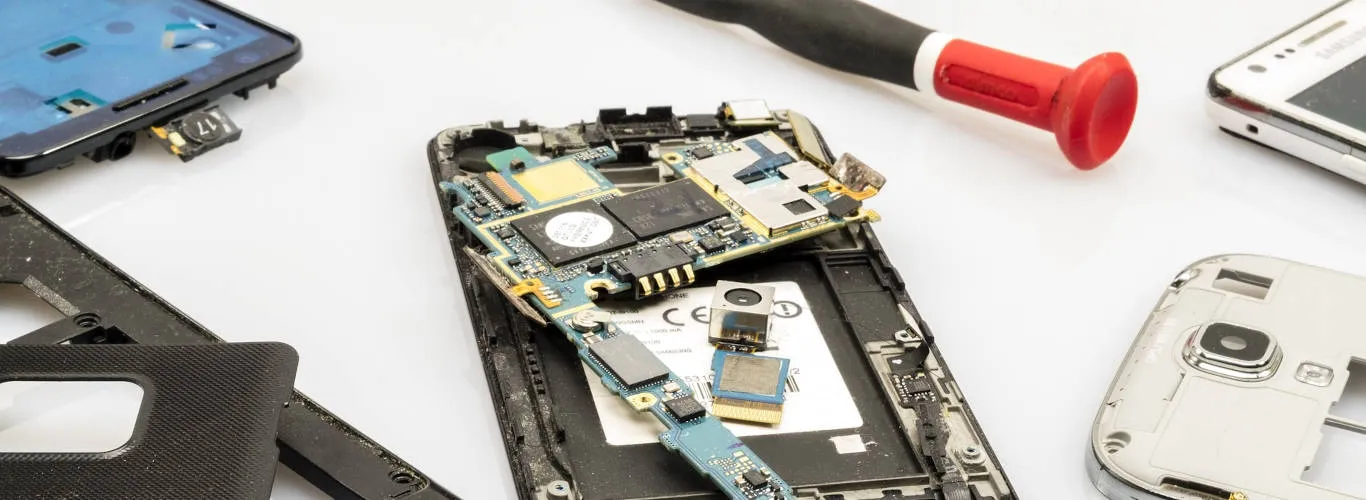If you are interested in ecology and recycling - sign up for our newsletter
Why does the repairability of electronic devices matter?
Repairability of Electronic Devices refers to the ability to easily service, replace parts, and extend the lifespan of a product. In an era of rapid technological development and the constant introduction of new electronic device models, repairability becomes a key factor in reducing electronic waste (e-waste). Here are some reasons why promoting this idea is important:
Reducing Electronic Waste: E-waste is one of the fastest-growing sources of waste globally. According to reports, over 50 million tons of electronic waste are generated annually, with only a small portion being properly processed. The ease of repairing devices can significantly reduce this number, as products that can be repaired are less likely to end up in landfills.
Conserving Natural Resources: The production of electronic devices requires substantial resources, including rare metals that are difficult to obtain and often mined in environmentally harmful ways. The ease of repair allows for extending the life of devices, reducing the demand for new raw materials and resources.
Reducing CO2 Emissions: The production of new electronic devices is associated with high emissions of carbon dioxide and other greenhouse gases. Extending the lifespan of existing products through repair can help reduce CO2 emissions, contributing to the fight against climate change.
Supporting the Circular Economy: The repairability of electronic equipment is one of the foundations of the circular economy, which aims to minimize waste and maximize the reuse of materials. Instead of promoting a "buy-discard" model, repairability supports a "buy-repair-use" model, contributing to sustainable development.
Increasing Consumer Awareness: The ability to repair devices influences consumer behavior, encouraging more responsible purchasing choices. Consumers who know they can repair their devices instead of replacing them are more likely to invest in durable and environmentally friendly products.
Designing for Easy Repair: Key Principles and Practices
Designing electronic devices with ease of repair in mind is becoming increasingly important in the context of combating the growing problem of electronic waste. A key principle in this process is the careful selection of components and materials. Manufacturers should choose parts that are readily available and standardized, enabling quick replacement. Components should not be permanently attached to the device using adhesives or soldering but rather with screws or clips, making them easier to disassemble and replace.
Another crucial aspect is modular design. With a modular structure, individual parts of the device can be replaced independently, without the need to replace the entire product. For example, replacing a single damaged component, such as a battery or display, should not require disassembling the entire device. This practice significantly reduces repair costs and minimizes the number of parts that become unnecessary waste.
It is also important to provide access to information about the construction and operation of the device. Manufacturers should supply detailed repair instructions and technical documentation to facilitate repairs by both technicians and consumers themselves. Access to such information extends the lifespan of equipment, as users can address minor problems on their own without needing to purchase a new device.
Using materials that are more resistant to wear and easier to recycle also plays a key role. Choosing materials with longer lifespans that can be recycled multiple times makes devices more durable and easier to repair. Moreover, using environmentally friendly raw materials minimizes the impact on the ecosystem during production and after the product's life cycle ends.
Innovative technological solutions can also support the idea of reparability. The introduction of open-source designs, which allow software modifications, enables users to use their devices for longer. Software updates should be available for a long time, even after the model is no longer in production, ensuring extended functionality and reducing the pressure on consumers to buy new devices.
Economic and ecological benefits of repairability of equipment
Designing electronic devices with easy repairability in mind brings significant benefits for both consumers and the environment. From an economic perspective, repairing equipment is usually a cheaper alternative to buying new devices. Consumers can save money by extending the lifespan of their existing equipment. Instead of incurring the costs associated with purchasing new products, users can spend smaller amounts on repairs, which in turn stimulates the local economy by supporting repair services. As a result, repair businesses can grow their operations, creating jobs and boosting local markets.
From an ecological standpoint, easy repairability of devices is crucial in addressing the growing problem of electronic waste. When equipment is repairable, its lifespan is extended, reducing the need for manufacturing new devices. This leads to a decrease in the consumption of natural resources, including rare metals essential for electronics production. Limiting the extraction and processing of these resources helps reduce negative environmental impacts, such as ecosystem degradation and greenhouse gas emissions.
Additionally, reducing the production of new devices and extending the lifespan of existing products decreases the demand for energy required for their manufacture. Electronics production is an energy-intensive process that generates large amounts of carbon dioxide emissions. Fewer devices on the market mean lower energy consumption, contributing to a reduced carbon footprint for the entire technology sector.
The economic and ecological benefits of repairable electronic devices are therefore interconnected and mutually reinforcing, creating a positive cycle that benefits both the economy and the environment.
Initiatives and regulations supporting the repairability of electronics
In recent years, numerous initiatives and regulations have emerged to support the repairability of electronic devices. One of the most significant trends is the implementation of laws that require manufacturers to design equipment with easier repairability in mind. An example of this is the European Union's regulations, such as the so-called "right to repair," which mandates that manufacturers provide spare parts and repair instructions to users and independent repair shops for a specified period after the purchase of a device. These regulations aim to extend the lifespan of products, directly contributing to the reduction of electronic waste.
Furthermore, local initiatives promoting repairability are developing in many countries. Social movements, such as repair cafes and DIY workshops, are gaining popularity by educating the public on self-repair and encouraging the restoration of devices to full functionality instead of discarding them. These organizations often collaborate with local authorities, who support these efforts through funding or organizing public awareness campaigns.
Non-governmental organizations and lobbying groups are also actively advocating for stricter repairability regulations. For example, campaigns by organizations like iFixit have long fought for consumers' rights to repair their devices by publishing detailed repair guides and ratings on the ease of repairing various products. Such actions aim to increase consumer awareness and put pressure on manufacturers to make changes in their product designs.
It is also worth noting that some companies are beginning to recognize the growing interest in repairability among consumers and are adjusting their strategies accordingly. Manufacturers like Fairphone and Framework focus on open design, providing spare parts, and offering easily accessible repair instructions, demonstrating that it is possible to introduce more repairable devices to the market without compromising competitiveness.
These examples show that initiatives and regulations supporting the repairability of electronics are gaining importance worldwide, becoming a key element in the fight against the growing problem of electronic waste.
The Future of Repairable Devices: How Can Consumers Drive Change?
Consumer awareness of the impact of their purchasing decisions on the environment is growing every year, directly affecting the electronics industry. More and more people are realizing that by choosing devices that are easy to repair, they can significantly reduce the amount of electronic waste generated. In practice, this means increased interest in products designed for longevity, easy access to spare parts, and instructions that enable self-repair.
Consumers also have the ability to put pressure on manufacturers through conscious choices and by using platforms that evaluate products based on their repairability. For example, platforms like iFixit provide product ratings in terms of repairability, allowing consumers to make more informed decisions. By purchasing devices from manufacturers who promote transparency, provide repair tools, and supply spare parts, consumers can actively support companies taking eco-friendly actions. This can lead to higher demand for repairable products, forcing other companies to adapt to new market expectations.
The "right to repair," mentioned above, is also becoming increasingly popular and is a topic of debate and legislation in many countries. Supporting legislative initiatives that require manufacturers to provide documentation, tools, and parts for repair is another way consumers can influence the future of repairable devices. In this way, they exert pressure on governments to introduce regulations that promote responsible production practices.
The growing popularity of social groups and workshops that encourage repairing electronics instead of discarding them is also significant. These initiatives work to change consumer mindsets, promoting the idea that repairing is not only a way to save money but also an important ecological practice. Education and social awareness about the benefits of repairable devices can gradually change consumer purchasing priorities, steering them toward more sustainable choices.
Consumers have a real power to influence the market and the future of electronics through their daily decisions, supporting pro-environmental initiatives, and actively participating in the dialogue about the right to repair. Every conscious choice and action brings us closer to a world where repairability becomes the standard, not the exception.
The repairability of electronic devices is a key element in the fight against the growing problem of electronic waste, which is one of the fastest-growing waste streams worldwide. Designing devices with easy repair in mind – through the use of modular components, standard screws, availability of repair manuals, and spare parts – can significantly extend the lifespan of equipment, thereby reducing the need to purchase new devices and limiting the number of discarded products.
The benefits of repairability include not only waste reduction but also savings for consumers and advantages for manufacturers, who can build their reputation on environmental care. Support for repairability is also increasingly present in public policy, with numerous regulations and initiatives promoting the right to repair.
Raising consumer awareness about repair options, along with their active choices, can become a significant factor in pressuring manufacturers to introduce more sustainable products. In the future, easy repair of devices may become the standard, bringing benefits not only for our wallets but also for the planet, significantly reducing electronic waste and supporting sustainable development.






